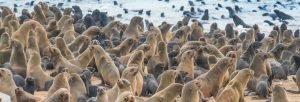
Bwabwata National Park
The park was first proclaimed as the Caprivi Game Reserve in 1966 and upgraded to the Caprivi Game Park in 1968. It was gazetted as the Bwabwata National Park in 2007 and
incorporated the former Mahango Game Reserve. The park has had a chequered history as it was declared a military area by the South African Defence Force during Namibia’s war of liberation. It was not until after Independence in 1990 that the park could be properly run as a conservation area.
A survey was conducted in the park at Independence to investigate the status of the fauna and flora after the military occupation and to assess the circumstances of the 5 000 people living in it. This survey laid the foundation for the current management approach in the park, which incorporates the needs of the people living there. The survey also laid the foundation for the zoning of the park, which has a core conservation area in the west along the Okavango River, a multiple use area in the central part of the park and a core conservation area in the east along the Kwando River.
Development of infrastructure, provision of equipment and park planning is being supported by the German Development Bank (KfW) through the Bwabwata, Mudumu, and Mamili (BMM) Parks Project and by the Global Environment Fund through the Strengthening the Protected Area Network (SPAN) Project.
NAMIBIA
The Bwabwata National Park is bordered by the Okavango River to the west and Kwando River to the east where water lilies abound.
Park size 6 100 km²
Proclamation Bwabwata National Park in 2007 Natural features Low vegetated sand dunes with old drainage lines (omurambas) in between. The Okavango River in the west and the Kwando River in the east. Vegetation Broad-leafed Kalahari woodland with trees such as Zambezi teak and false mopane on the sandy areas, and camelthorn and leadwood in the marimbas. Reeds and papyrus on the floodplains, which are lined with trees such as Jackal-berry, mangosteen, knob thorn and makalani palm.
Wildlife Large concentrations of elephant and buffalo, also sable and roan antelope. Main predators such as lion, leopard, cheetah and hyaena. One of the last refuges of the wild dog in Namibia. Common reedbuck, red lechwe, sitatunga and hippo along the rivers.
Birds include Wattled Crane, African Skimmer Western- banded Snake Eagle, Wood Owl, Pel’s Fishing Owl, Narina Trogon, Cape Parrot, and both Red-billed and Yellow-billed Oxpeckers.













